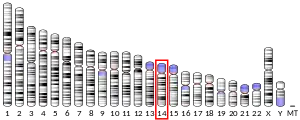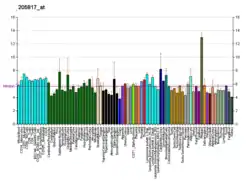Homeobox protein SIX1 (Sine oculis homeobox homolog 1) is a protein that in humans is encoded by the SIX1 gene.[5][6][7]
Function
The vertebrate SIX genes are homologs of the Drosophila 'sine oculis' (so) gene, which is expressed primarily in the developing visual system of the fly. Members of the SIX gene family encode proteins that are characterized by a divergent DNA-binding homeodomain and an upstream SIX domain, which may be involved both in determining DNA-binding specificity and in mediating protein–protein interactions. Genes in the SIX family have been shown to play roles in vertebrate and insect development or have been implicated in maintenance of the differentiated state of tissues.[supplied by OMIM][7]
Interactions
SIX1 has been shown to interact with EYA1,[8] DACH, GRO and MDFI.[9]
References
- 1 2 3 GRCh38: Ensembl release 89: ENSG00000126778 - Ensembl, May 2017
- 1 2 3 GRCm38: Ensembl release 89: ENSMUSG00000051367 - Ensembl, May 2017
- ↑ "Human PubMed Reference:". National Center for Biotechnology Information, U.S. National Library of Medicine.
- ↑ "Mouse PubMed Reference:". National Center for Biotechnology Information, U.S. National Library of Medicine.
- ↑ Boucher CA, Carey N, Edwards YH, Siciliano MJ, Johnson KJ (April 1996). "Cloning of the human SIX1 gene and its assignment to chromosome 14". Genomics. 33 (1): 140–2. doi:10.1006/geno.1996.0172. PMID 8617500.
- ↑ Ruf RG, Xu PX, Silvius D, Otto EA, Beekmann F, Muerb UT, Kumar S, Neuhaus TJ, Kemper MJ, Raymond RM, Brophy PD, Berkman J, Gattas M, Hyland V, Ruf EM, Schwartz C, Chang EH, Smith RJ, Stratakis CA, Weil D, Petit C, Hildebrandt F (May 2004). "SIX1 mutations cause branchio-oto-renal syndrome by disruption of EYA1-SIX1-DNA complexes". Proceedings of the National Academy of Sciences of the United States of America. 101 (21): 8090–5. Bibcode:2004PNAS..101.8090R. doi:10.1073/pnas.0308475101. PMC 419562. PMID 15141091.
- 1 2 "Entrez Gene: SIX1 sine oculis homeobox homolog 1 (Drosophila)".
- ↑ Buller C, Xu X, Marquis V, Schwanke R, Xu PX (November 2001). "Molecular effects of Eya1 domain mutations causing organ defects in BOR syndrome". Human Molecular Genetics. 10 (24): 2775–81. doi:10.1093/hmg/10.24.2775. PMID 11734542.
- ↑ Rual JF, Venkatesan K, Hao T, Hirozane-Kishikawa T, Dricot A, Li N, Berriz GF, Gibbons FD, Dreze M, Ayivi-Guedehoussou N, Klitgord N, Simon C, Boxem M, Milstein S, Rosenberg J, Goldberg DS, Zhang LV, Wong SL, Franklin G, Li S, Albala JS, Lim J, Fraughton C, Llamosas E, Cevik S, Bex C, Lamesch P, Sikorski RS, Vandenhaute J, Zoghbi HY, Smolyar A, Bosak S, Sequerra R, Doucette-Stamm L, Cusick ME, Hill DE, Roth FP, Vidal M (October 2005). "Towards a proteome-scale map of the human protein–protein interaction network". Nature. 437 (7062): 1173–8. Bibcode:2005Natur.437.1173R. doi:10.1038/nature04209. PMID 16189514. S2CID 4427026.
Further reading
- Oliver G, Wehr R, Jenkins NA, Copeland NG, Cheyette BN, Hartenstein V, Zipursky SL, Gruss P (March 1995). "Homeobox genes and connective tissue patterning". Development. 121 (3): 693–705. doi:10.1242/dev.121.3.693. hdl:11858/00-001M-0000-0013-037D-E. PMID 7720577.
- Adrados I, Larrasa-Alonso J, Galarreta A, López-Antona I, Menéndez C, Abad M, Palmero I (2015). "The homeoprotein SIX1 controls cellular senescence through the regulation of p16INK4A and differentiation-related genes". Oncogene. 35 (27): 3485–3494. doi:10.1038/onc.2015.408. PMC 5730042. PMID 26500063.
- Ford HL, Kabingu EN, Bump EA, Mutter GL, Pardee AB (October 1998). "Abrogation of the G2 cell cycle checkpoint associated with overexpression of HSIX1: a possible mechanism of breast carcinogenesis". Proceedings of the National Academy of Sciences of the United States of America. 95 (21): 12608–13. Bibcode:1998PNAS...9512608F. doi:10.1073/pnas.95.21.12608. PMC 22878. PMID 9770533.
- Salam AA, Häfner FM, Linder TE, Spillmann T, Schinzel AA, Leal SM (June 2000). "A novel locus (DFNA23) for prelingual autosomal dominant nonsyndromic hearing loss maps to 14q21-q22 in a Swiss German kindred". American Journal of Human Genetics. 66 (6): 1984–8. doi:10.1086/302931. PMC 1378045. PMID 10777717.
- Ford HL, Landesman-Bollag E, Dacwag CS, Stukenberg PT, Pardee AB, Seldin DC (July 2000). "Cell cycle-regulated phosphorylation of the human SIX1 homeodomain protein". The Journal of Biological Chemistry. 275 (29): 22245–54. doi:10.1074/jbc.M002446200. PMID 10801845.
- Fan X, Brass LF, Poncz M, Spitz F, Maire P, Manning DR (October 2000). "The alpha subunits of Gz and Gi interact with the eyes absent transcription cofactor Eya2, preventing its interaction with the six class of homeodomain-containing proteins". The Journal of Biological Chemistry. 275 (41): 32129–34. doi:10.1074/jbc.M004577200. PMID 10906137.
- Buller C, Xu X, Marquis V, Schwanke R, Xu PX (November 2001). "Molecular effects of Eya1 domain mutations causing organ defects in BOR syndrome". Human Molecular Genetics. 10 (24): 2775–81. doi:10.1093/hmg/10.24.2775. PMID 11734542.
- Li CM, Guo M, Borczuk A, Powell CA, Wei M, Thaker HM, Friedman R, Klein U, Tycko B (June 2002). "Gene expression in Wilms' tumor mimics the earliest committed stage in the metanephric mesenchymal-epithelial transition". The American Journal of Pathology. 160 (6): 2181–90. doi:10.1016/S0002-9440(10)61166-2. PMC 1850829. PMID 12057921.
- Ikeda K, Watanabe Y, Ohto H, Kawakami K (October 2002). "Molecular interaction and synergistic activation of a promoter by Six, Eya, and Dach proteins mediated through CREB binding protein". Molecular and Cellular Biology. 22 (19): 6759–66. doi:10.1128/MCB.22.19.6759-6766.2002. PMC 134036. PMID 12215533.
- López-Ríos J, Tessmar K, Loosli F, Wittbrodt J, Bovolenta P (January 2003). "Six3 and Six6 activity is modulated by members of the groucho family". Development. 130 (1): 185–95. doi:10.1242/dev.00185. PMID 12441302.
- Ruf RG, Berkman J, Wolf MT, Nurnberg P, Gattas M, Ruf EM, Hyland V, Kromberg J, Glass I, Macmillan J, Otto E, Nurnberg G, Lucke B, Hennies HC, Hildebrandt F (July 2003). "A gene locus for branchio-otic syndrome maps to chromosome 14q21.3-q24.3". Journal of Medical Genetics. 40 (7): 515–9. doi:10.1136/jmg.40.7.515. PMC 1735534. PMID 12843324.
- Zheng W, Huang L, Wei ZB, Silvius D, Tang B, Xu PX (September 2003). "The role of Six1 in mammalian auditory system development". Development. 130 (17): 3989–4000. doi:10.1242/dev.00628. PMC 3873880. PMID 12874121.
- Li X, Oghi KA, Zhang J, Krones A, Bush KT, Glass CK, Nigam SK, Aggarwal AK, Maas R, Rose DW, Rosenfeld MG (November 2003). "Eya protein phosphatase activity regulates Six1-Dach-Eya transcriptional effects in mammalian organogenesis". Nature. 426 (6964): 247–54. Bibcode:2003Natur.426..247L. doi:10.1038/nature02083. PMID 14628042. S2CID 4348941.
- Coletta RD, Christensen K, Reichenberger KJ, Lamb J, Micomonaco D, Huang L, Wolf DM, Müller-Tidow C, Golub TR, Kawakami K, Ford HL (April 2004). "The Six1 homeoprotein stimulates tumorigenesis by reactivation of cyclin A1". Proceedings of the National Academy of Sciences of the United States of America. 101 (17): 6478–83. Bibcode:2004PNAS..101.6478C. doi:10.1073/pnas.0401139101. PMC 404070. PMID 15123840.
- Grifone R, Laclef C, Spitz F, Lopez S, Demignon J, Guidotti JE, Kawakami K, Xu PX, Kelly R, Petrof BJ, Daegelen D, Concordet JP, Maire P (July 2004). "Six1 and Eya1 expression can reprogram adult muscle from the slow-twitch phenotype into the fast-twitch phenotype". Molecular and Cellular Biology. 24 (14): 6253–67. doi:10.1128/MCB.24.14.6253-6267.2004. PMC 434262. PMID 15226428.
- Rual JF, Venkatesan K, Hao T, Hirozane-Kishikawa T, Dricot A, Li N, Berriz GF, Gibbons FD, Dreze M, Ayivi-Guedehoussou N, Klitgord N, Simon C, Boxem M, Milstein S, Rosenberg J, Goldberg DS, Zhang LV, Wong SL, Franklin G, Li S, Albala JS, Lim J, Fraughton C, Llamosas E, Cevik S, Bex C, Lamesch P, Sikorski RS, Vandenhaute J, Zoghbi HY, Smolyar A, Bosak S, Sequerra R, Doucette-Stamm L, Cusick ME, Hill DE, Roth FP, Vidal M (October 2005). "Towards a proteome-scale map of the human protein–protein interaction network". Nature. 437 (7062): 1173–8. Bibcode:2005Natur.437.1173R. doi:10.1038/nature04209. PMID 16189514. S2CID 4427026.
- Ito T, Noguchi Y, Yashima T, Kitamura K (May 2006). "SIX1 mutation associated with enlargement of the vestibular aqueduct in a patient with branchio-oto syndrome". The Laryngoscope. 116 (5): 796–9. doi:10.1097/01.mlg.0000209096.40400.96. PMID 16652090. S2CID 19273457.




